Bear Dogs: The Best 5 Breeds for Hunting Bruins
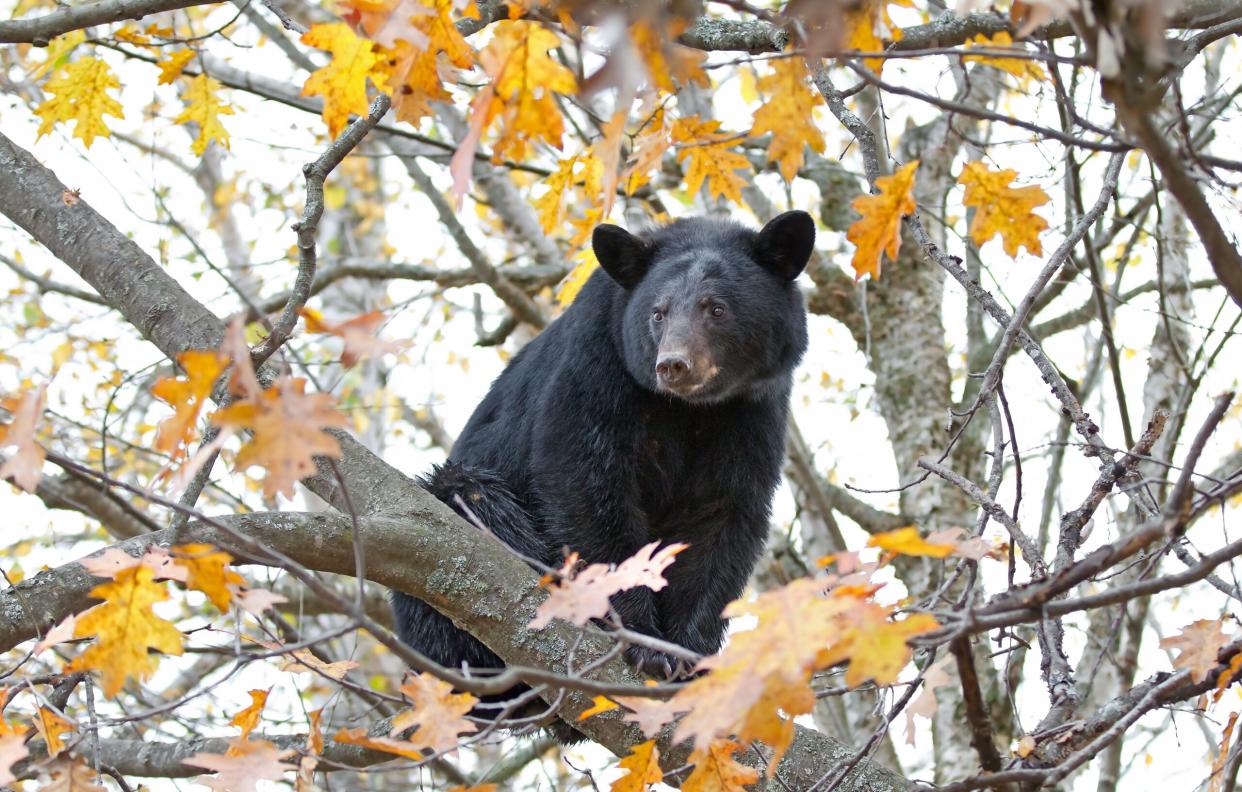
Did you know that Airedale terriers were once used as bear hunting dogs? They were known to be fearless and especially nasty. Today, more Airedales are found on the couch than nose-down on the track of a big bruin. But there are a number of other bear hunting dog breeds suited to the task and ready for the chase.
Following a pack of hounds is just about the most exciting way to hunt bears. Once the dogs strike a track, they can be on it for miles through unforgiving terrain. If you live in one of the handful of states where hunting bears with dogs is legal, I suggest giving it a try. If you do, you might even find yourself wanted to get some bear dogs. So, with that in mind, here's a rundown of the top bruin-chasing breeds.

What Makes a Good Bear Dog?
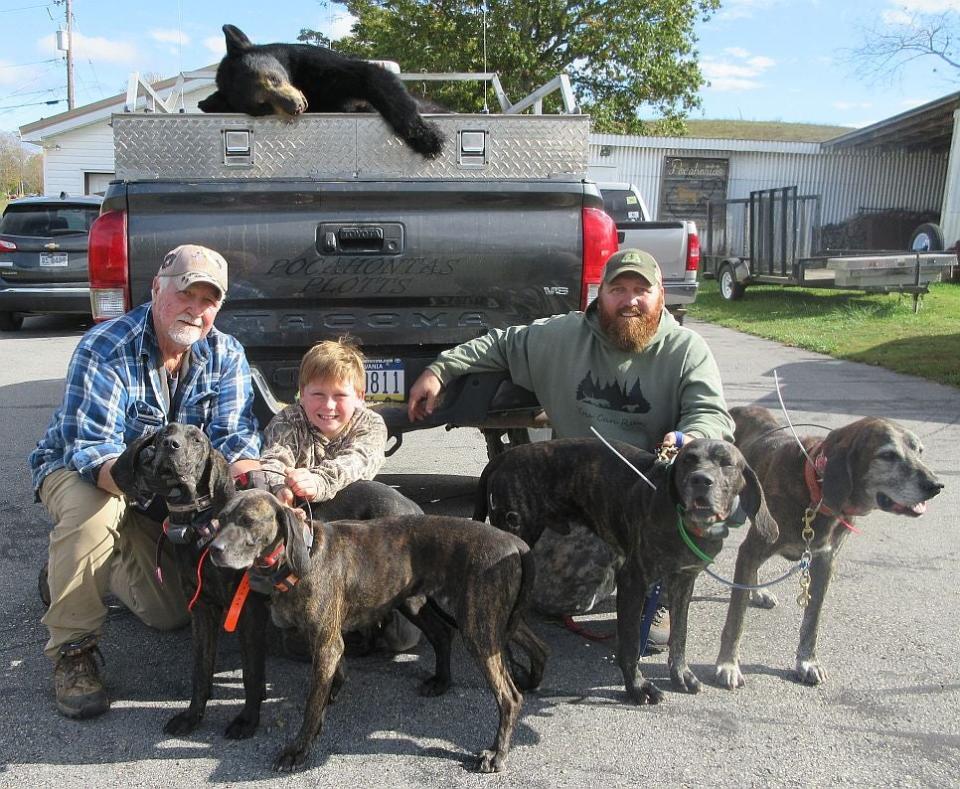
A good bear dog needs to have a good nose, exceptional prey drive, and a relentless attitude to keep up with a bear. Most bear dogs are larger hounds that are bred to cover ground. A hunter who taught me about bear hunting with hounds broke his dogs into two categories: the leaders and the cheerleaders. Both were valuable, but he relied on and trusted his lead dogs to “strike” or find a bear track.
His lead dogs were so good, they could sound off on a bear track that crossed the road in front of us as we were driving in the truck. The cheerleaders were there for support. They were less experienced dogs that followed along, but they were tenacious enough to keep the bear where it needed to be until we arrived. The ideal bear dog has a nose that you can trust and enough drive to chase a bear and keep it up in a tree for hours. But a dog that either quality can be useful in bear hunting pack.
Related: How to Survive a Bear Attack
Bear Dogs: The Best 5 Hunting Breeds
1. Plott Hound
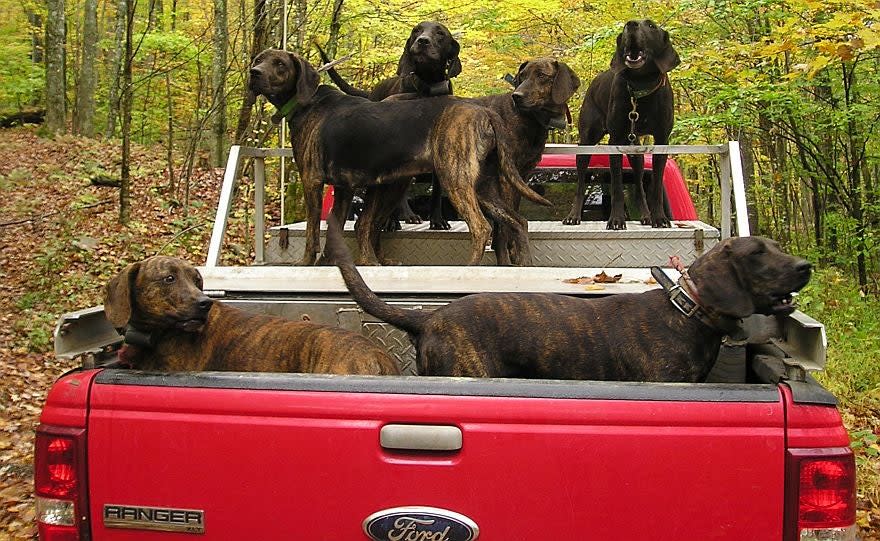
The bear dogs I’ve spent most of my time with were Plott hounds. When I saw them in action, I was blown away. They would jump off of cliffs without hesitation, hurdle up near-vertical slopes, swim across ice-cold rivers, and back down any bear they came across. It gave a whole new weight to the phrase “release the hounds.”
Plotts were bred to be bear hunting super dogs in the late 1700s. German immigrant Johannes Plott arrived in North Carolina in 1790 with five Hanover hounds in tow for hunting purposes. His son bred them to local stock, eventually resulting in the Plott Hound. Plotts are muscular with a short, dark brindle coat and a long tail. They range in size from 40 to 60 pounds. When it comes to chasing bears in mountainous country, they are nothing short of relentless.
2. Walker Hound
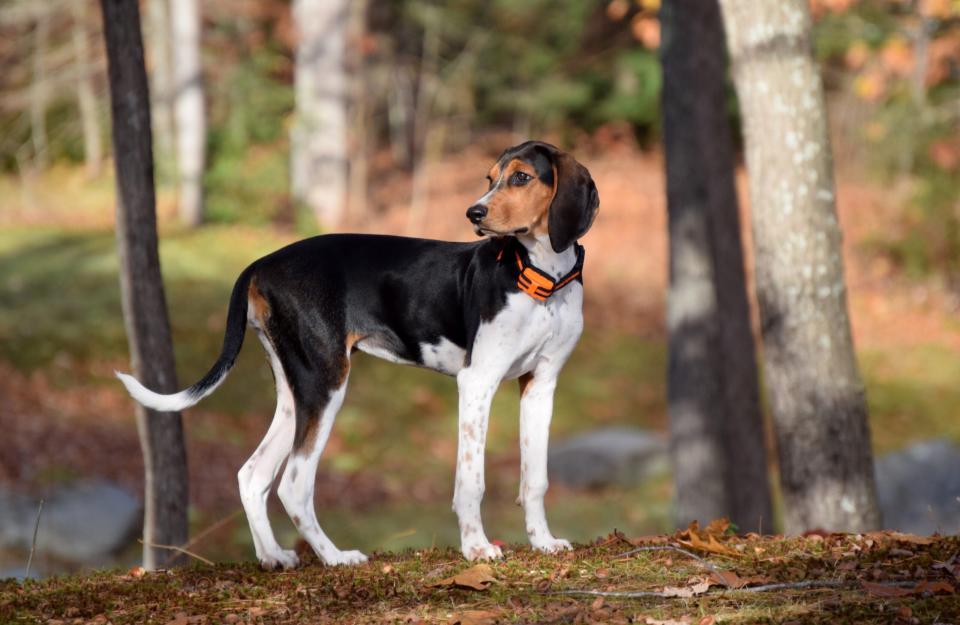
Walker bear dogs are usually broken into two sub-categories: running walkers and treeing walkers. As the names suggest, one is bred to run and the other to tree a bear quickly. Some breeders will mix the two, giving you a bear dog with the best of both. Walkers have long legs and a powerful stride to help them cover ground in a hurry. They’re also about as smart as a hound can be and very vocal, which is good if you need to locate them on a treed bear in dense woods.
The breed as we know it today dates back to the 1700s in Virginia, which was then part of Kentucky. The story goes that a man named Tom Harris stole a black-and-tan dog of unknown origin named “Tennessee Lead” during a deer hunt and sold him to a breeder named George Washington Maupin. The dog impressed Maupin and all of his hunting buddies, and they started breeding him with their hounds. The records of the stolen dog’s offspring are murky, if not all but gone, but many think this is how the treeing walker coonhound came to be. Running walkers were first bred in the mid- to late-1800s. They were developed to hunt foxes, rabbits, coyotes, and anything else that ran, but they lacked the treeing instinct of their cousins.
3. Blackmouth Cur
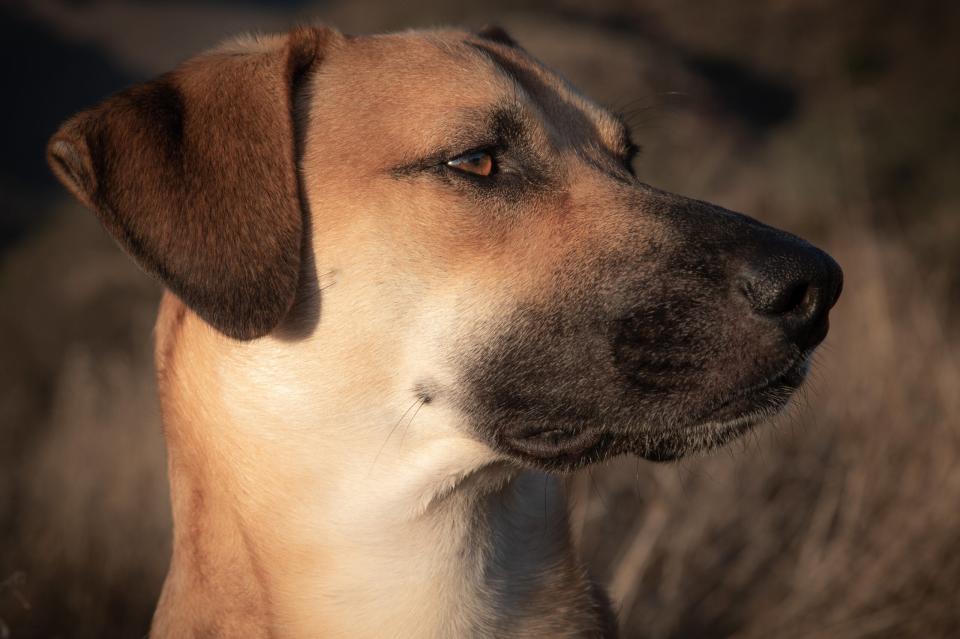
Blackmouth curs were bred to be general-purpose farm and hunting dogs in the southeastern U.S. throughout the 1800s. Today, there are breeders all over the country who raise blackmouth curs for hunting. The breed gets its name from distinct black pigmentation around the mouth. They are also called the Southern cur, yellow blackmouth cur, East Texas cur, or American blackmouth cur and range in size from 35 to 75 pounds. The general-purpose nature of the blackmouth cur is great for those who want to hunt other treeing animals like mountain lions, squirrels, raccoons, and bobcats. Cur owners also hunt hogs with their dogs. Blackmouth curs are tough and can kill varmints like a coyote should they end up in a fight with one. But they also make good family dogs, and they’re known to be gentle with children. On the trail for bears, blackmouth curs are fearless with plenty of stamina to keep up over all kinds of terrain. Look for a breeder with a track record for raising blackmouth cur bear dogs.
4. Redtick Coonhound
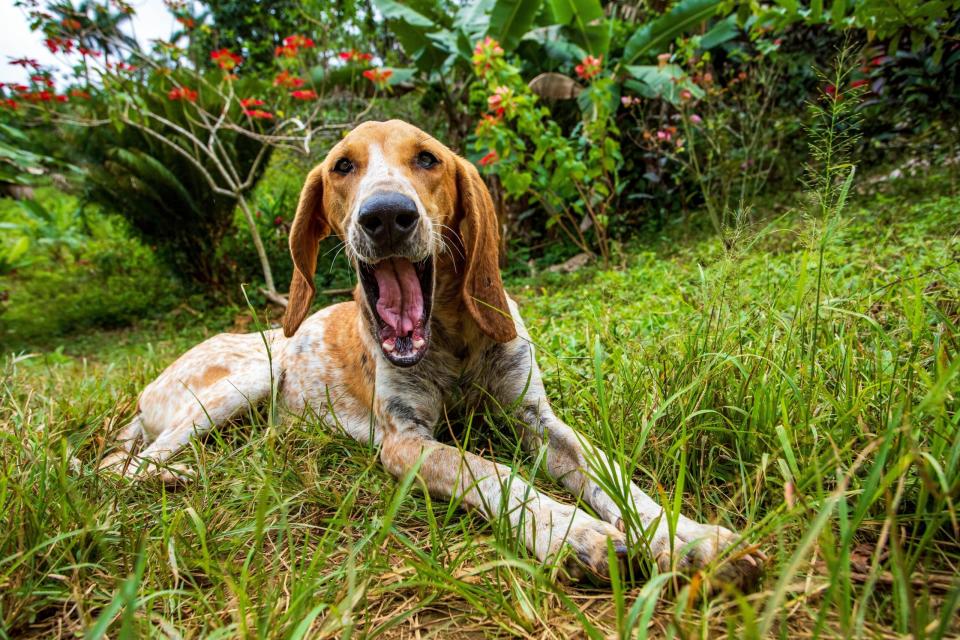
Also known as the English coonhound or American English coonhound, the redtick is better suited to hunting bears than its cousin, the bluetick. Redticks are fast and driven with a sensitive nose. Their drive comes at a price, though, as some owners find them to be stubborn and difficult to train. When you do have one trained, however, you’ll have a hound with a one-track mind geared toward finding and treeing a bear.
Like many of the coonhound breeds, redticks come from English stock that was brought to the U.S. during the Colonial era. Slowly, the dogs were bred for characteristics that helped them adapt better to the American landscape. At that time, the dogs would hunt raccoons at night and foxes during the day.
5. Karelian Bear Dog
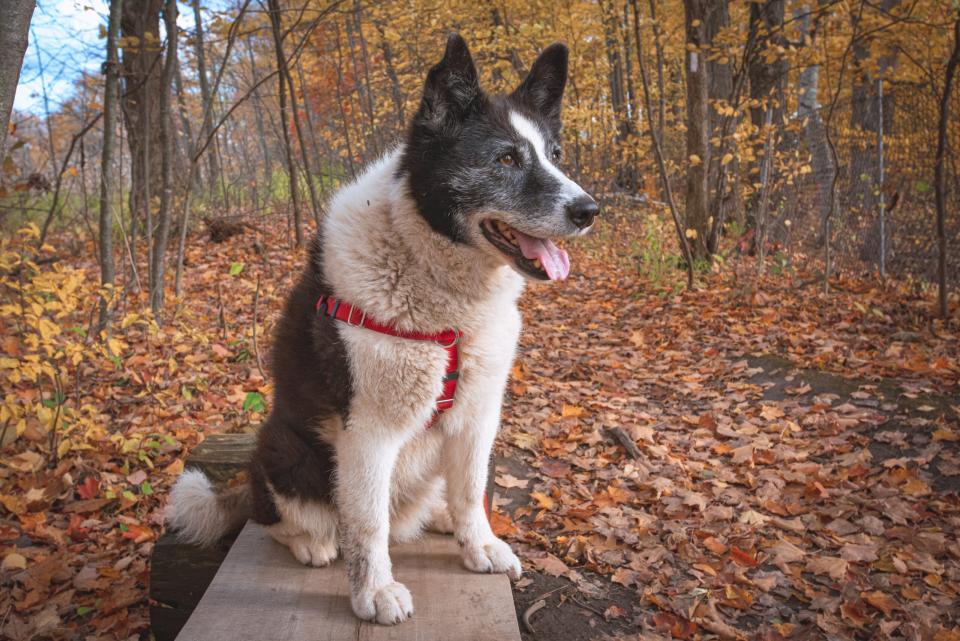
Breaking from the pack, the Karelian bear dog is not a hound, nor does it have roots in the U.S. The dogs come from Finland and they were bred to hunt wild boar. American bear hunters don’t typically run Karelians, but the few who do appreciate their drive and strong will. The dogs won’t sound off on the trail while chasing bears, rather they’re used as “stopping dogs” to hold bears in place until the hunter arrives. Karelians hunt in pairs and will only bark at game they can see. They also make good guard dogs and can be used to hunt small game.
The breed is also the youngest in our list, dating back to the mid-1930s when hunters crossed dogs from Lagoda’s Karelia, Olonets, and Russian Karelia stock. Their goal was to develop a versatile, strong dog capable of hunting big game. Karelian bear dogs were first registered in 1946.
Related: The 21 Best Hunting Dog Breeds
How to Pick a Bear Dog Pup
Look for breeders that have a history of raising dogs to hunt bears specifically. Once you’ve found one, inquire about the hunting history, health history, and temperament of the parent dogs of the litter. Ask how the parent dogs behave on a trail and how they work with a hunter. Good bear dog breeders will have this information on hand.
When it comes to picking a bear dog pup, you want to look for one with confidence. Pay attention to pups that naturally trail scent and bark at animals that are bigger than them. Get down on the ground with the pups and watch how each one reacts to your presence. Avoid pups that are shy or timid, as they may not be up to the task.
Whatever you choose, know that you’re in for a challenge. Drive, tenacity, and confidence in a pup can translate to a dog that is more difficult to train than others. Establish that you’re in charge early, but remember to be patient. The best way to learn how to train a bear dog is to find others who’ve done it in the past and listen to their advice.

